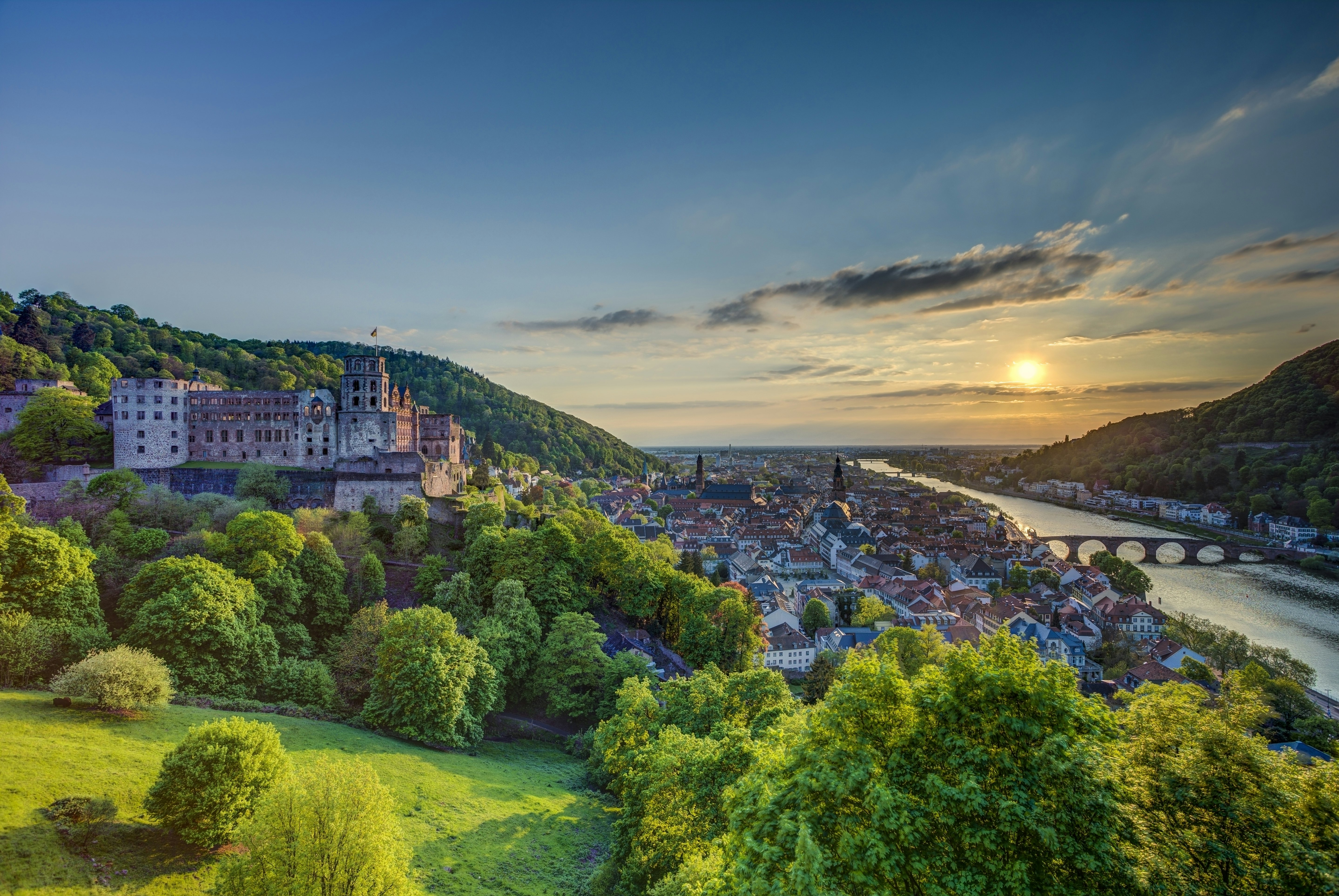Explore Germany for €9 this summer: these are the best itineraries to see the most for less

Jul 15, 2022 • 6 min read

Germany is selling €9 monthly transit tickets now through August; Hamburg, Germany © Lukassek / Getty
The incredibly cheap 9 euro summer travel pass in Germany has been a success.
More than 20 million tickets were sold in May, and around 10 million more public transport season ticket holders benefited from the offer. Even though there have been some issues with overcrowded trains on weekends and holidays, the general opinion among both the German government and the public is positive: there are fewer traffic jams all across Germany, and locals have an incentive to use more public transportation.
Details on what the 9-euro transit pass includes
For only €9 (US$ 9), anyone who purchases this ticket can travel as many times as they want on all forms of public transport throughout Germany, including buses, U-Bahns, S-Bahns, trams and local and regional trains for one calendar month.
Though it does not include long-distance trains like the IC or ICE trains and the ticket is non-transferable, there has never been such a good offer available in Germany.

How much longer will this offer be available?
The 9-euro ticket is still available now through August 31, 2022. Even though you may be asking yourself, "why have I not heard about this before?", we are here to give you all the info along with the best itineraries to optimize this new affordable pass.
Top 10 national parks in Germany
How to get your 9-euro ticket
Tickets are extremely easy to get. The fastest and most convenient option is through the DB Navigator App (Germany's official railway company’s app) or any website or app of one of the different regional transport companies.
With this method, you must create a profile with your full name and payment method and purchase the ticket online. The ticket will display directly on the app, and you just have to show it each time a controller asks to see it.
For those who prefer to get the 9-euro ticket on paper, you can purchase it using cash or credit cards at the ticket machines located in all stations and customer centers nationwide. In this case, you must always keep the ticket with you and write your name on the printed ticket for the controller to check.

Keep in mind the ticket doesn't include long-distance trips
One of the biggest disadvantages of the 9 euro ticket is that you won't be able to take long-distance trains, buses and trains from private companies like Flixbus/Flixtrain. This can be a bummer for those wanting to cover long distances. Regional trains are pretty slow, and traveling from one side of the country to the other can take almost a day.
Still, for a first-timer in Germany, I recommend combining the benefits of the 9 euro ticket with the efficiency of long-distance trains.
You can travel in less than a few hours between distant cities like Berlin, Frankfurt, Munich, Cologne or Hamburg using high-speed trains, and once you are there, you can explore these cities or plan day trips to nearby destinations using the 9 euro ticket.
Plan carefully when you travel; with an increase of 10% of public transportation users nationwide and 25% in Berlin, buses and trains could be jam-packed during peak hours or on the weekend.
There have also been some complaints about delays on the trains. In this way, the scheme has been a victim of its own success, as the massive uptick in passenger numbers was difficult to anticipate, especially with recent struggles around lack of personnel.
Top 10 reasons to visit Bavaria
The best itineraries to explore with the €9 travel pass

The industrial heritage route of the Ruhrgebiet
Large-scale coal mines and steelworks characterized the landscape of the Ruhrgebiet for the majority of the 20th century. Today the mining is long gone, and the Ruhrgebiet has developed into an outdoor museum that celebrates its industrial past.
Start your trip in Dortmund, a city where travelers come for football and stay for its cultural richness. Here, the industrial route of the Ruhrgebiet begins. Once you have seen Dortmund, travel with regional trains to the cities of Bochum, Essen and Duisburg, where some of Germany's most impressive industrial sites await. Zeche Zollverein in Essen, an old coal mine turned into a Unesco-listed museum and Landschaftspark Duisburg, a decommissioned ironworks that now hosts concerts and parties, are the best places to explore.
Since all the cities of the Ruhrgebiet are within 100 km of each other, you can combine several towns in a single day or take your time and stay in each one to find out what makes them unique.
These top hikes in Germany show why walking is a way of life here
Germany's gorgeous northern coastline
Whether there is a 9-euro ticket available or not, most German beaches get overcrowded in the summer months. Even though Germany is not commonly associated with sand and sea, places like Sylt, Rügen and Lubmin have become hotspots for locals to enjoy cold drinks under the sun and have fun.
Hamburg or Bremen are good places to start. From here, regional trains can take you for a day trip to the coastal cities of Kiel, Bremerhaven or Cuxhaven in less than 2 hours.
If you want to experience a different side of Germany, you can travel all the way north and spend the weekend in Sylt, Germany's most popular island.
For those trying to get off the beaten track, Lübeck or Rostock are the best places to stay. They can be a base from which to easily travel to some of Germany's most remote beaches at the Priwall and Barendorf nature reserve, Vorpommersche Boddenlandschaft National Park and Jasmund National Park.

Fairy-tale medieval architecture in Bavaria
This is the Germany you know from books and fairy tales. Majestic castles with tall towers, old towns with narrow alleys and half-timbered houses. From the famous Neuschwanstein Castle to the charming Altstadt of Rothenburg ob der Tauber, Bavaria is a photogenic paradise that will make you feel like a character from a story by the Grimm brothers.
Start your Bavarian adventure in Munich. This is the largest city in southern Germany and the best place to plan day trips anywhere around the region.
For those looking to explore charming colorful towns, Füssen, Bamberg and Rothenburg ob der Tauber are the places to go. On the other hand, if you want a more cosmopolitan vibe with some baroque flair, Regensburg or Nurenberg are perfect for a more extended stay.
When exploring medieval castles, leave Neuschwanstein to the end and visit first the imposing Hohenschwangau Castle or the Burghausen Castle, the largest castle in the world.
Top 12 things to do when you visit Germany

Vineyards and hilly landscapes along the German Wine Route
You can't mention the Rhineland Palatinate without thinking about a glass of Riesling. This is the best region in Germany for wine lovers and home to over 1000 years of viniculture.
Start your trip from the picturesque Heidelberg, a university town renowned for its baroque Altstadt, beautiful riverside setting and impressive hilltop castle. Once you are ready to explore Germany’s wine culture, take a local train to the towns along the famous German Wine Route.
The best spots along the route are Bockenheim, Bad Dürkheim, Neustadt and Landau, where wine festivals take place between March till October, and wine tours can be easily scheduled. Still, no matter where you go, wine and food will be waiting for you. When it comes to specific wineries, Rhodter Rosengarten is a must. This is said to be a 400 years old winery, making it the oldest vineyard in Europe still in use.
When taking the train in between these towns, be sure to get a window seat. This is one of the most scenic train rides in Germany, and just witnessing the beautiful hilly landscape of the region makes the visit worth it.
Wine on the Rhine: three German wine regions off the beaten path






